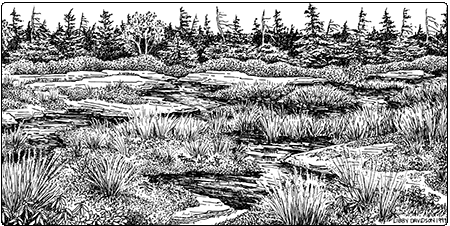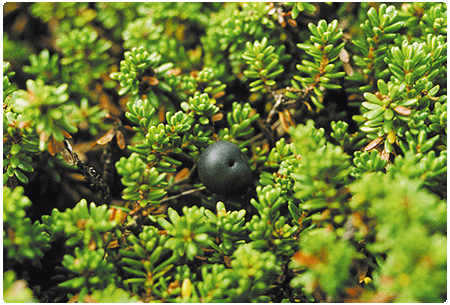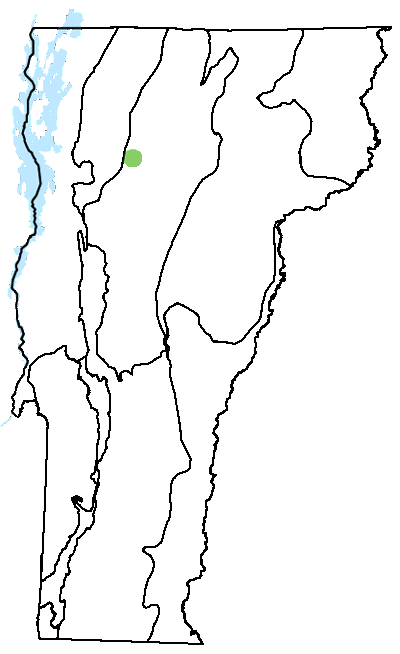Ecology and Physical Setting 
Alpine Peatlands in Vermont are very small wetland inclusions within the Alpine Meadow and Subalpine Krummholz on Mount Mansfield. They are also associated with cold, exposed Boreal Calcareous Cliffs in Smuggler’s Notch, but these examples are not well documented. The climate here is intense, with frequent fog, high winds, cold temperatures, and the most precipitation of anywhere in the state (over 70 inches annually). Alpine Peatlands occur in shallow bedrock depressions and on gentle slopes, where they stay saturated because of the abundant precipitation and fog. Seepage may also be an important input on slopes. Peat accumulation is less than two feet in basins and may be as little as six inches on gentle slopes. The peat does not get deeper because the bedrock basins are shallow, and peat can decompose during dry periods in the summer. On slopes, fully saturated peat is heavy and may slump and slide short distances. When this occurs near cliff edges, small lumps of peat dangle precariously over the edge, and eventually break off and fall.
While Alpine Peatlands are just a small fraction of Vermont’s alpine area, to our north the pattern reverses because of colder and wetter conditions. Similar peatlands predominate in the higher mountains of central Québec. There, a mountain can have a complex mix of bogs and patterned fens—fens with linear ridges and hollows called strings and flarks—and only isolated patches of dry tundra. Our small Alpine Peatlands are an intriguing link to these northern expanses.
Vegetation

alpine communities.
The boggier portions of Alpine Peatlands are dominated by low-growing heath shrubs, primarily alpine bilberry, leatherleaf, Labrador tea, and black crowberry. The bright red Sphagnum capillifolium forms a nearly continuous cover under the shrubs, with lichens common in some areas. Hare’s tail cottongrass, Bigelow’s sedge, and small cranberry may also be abundant. There are scattered, stunted balsam fir trees less than three feet tall.
The wetter, fen-like portions of Alpine Peatlands are a mixture of small pools and Sphagnum-dominated “lawns.” Floating in the shallow pools are scattered plants of Sphagnum cuspidatum, a weak-stemmed yellowish species that becomes stranded as the pools dry out in the summer. The greenish-black liverwort Gymnocolea inflata forms dense patches at the edges of the pools and in the lowest portions of the lawns. The moist lawns are carpeted by Sphagnum fallax and Sphagnum magellanicum with a dense cover of boreal bog sedge and hoary sedge. The rare deer-hair sedge grows in the sloping portions of the peatlands near the cliff edges.
Wildlife Habitat
Little is known about the animals that use these small high-elevation wetlands, but the same species found in Alpine Meadows likely occur here, too. White-throated sparrows nest in stunted balsam firs that occur on the fringes of the alpine zone. Blackpoll warblers and Bicknell’s thrushes nest in nearby montane forests and may visit these peatlands.
Related Communities
- Dwarf Shrub Bog occurs at lower elevations, has deeper peat, and typically has scattered black spruce and tamarack. It lacks alpine bilberry, black crowberry, and Bigelow’s sedge.
- Poor Fen also occurs at lower elevations and typically has stunted black spruce, tamarack, and red maple trees. Poor Fens typically have deep peat over mineral soils, in contrast with Alpine Peatlands which have very shallow layers of peat lying directly over bedrock.
Conservation Status and Management Considerations
Alpine Peatlands and other alpine communities are extremely rare in Vermont. The largest Alpine Peatlands on Mount Mansfield are owned and managed by the University of Vermont and are readily visible from the Long Trail. These small wetlands and other sensitive alpine communities are threatened by trampling of vegetation by curious visitors, and by development of infrastructure on the ridgeline. Decreased snowpack and increased summer droughts caused by climate change may threaten the long-term persistence of these peatlands.
Distribution/Abundance 
In Vermont, Alpine Peatlands occur only on Mount Mansfield. Similar communities are also known from alpine regions of the Adirondacks of New York
and the White Mountains of New Hampshire and Maine. They are more common to
the north in Canada.
Characteristic Plants
Trees (Stunted)
Occasional Species
Balsam fir – Abies balsamea
Paper birch – Betula papyrifera
Shrubs
Abundant Species
Alpine bilberry – Vaccinium uliginosum
Leatherleaf – Chamaedaphne calyculata
Labrador tea – Rhododendron groenlandicum
Occasional to Locally Abundant Species
Black crowberry – Empetrum nigrum
Bog laurel – Kalmia polifolia
Small cranberry – Vaccinium oxycoccos
Creeping snowberry – Gaultheria hispidula
Herbs
Abundant Species
Boreal bog sedge – Carex magellanica
Hare’s tail cottongrass – Eriophorum vaginatum
Hoary sedge – Carex canescens
Occasional to Locally Abundant Species
Billings’ sedge – Carex billingsii
Starflower – Lysimachia borealis
Goldthread – Coptis trifolia
Bigelow’s sedge – Carex bigelowii
Bryophytes and Lichens
Abundant Species
Moss – Sphagnum capillifolium
Moss – Sphagnum fallax
Moss – Sphagnum magellanicum
Moss – Sphagnum russowii
Moss – Warnstorfia fluitans
Lichen – Cetraria sp.
Occasional to Locally Abundant Species
Moss – Sphagnum cuspidatum
Bog haircap moss – Polytrichum strictum
Moss – Calliergon cordifolium
Liverwort – Gymnocolea inflata
Rare and Uncommon Plants
Bigelow’s sedge – Carex bigelowii
Deer-hair sedge – Tricophorum cespitosum
Alpine bilberry – Vaccinium uliginosum
Black crowberry – Empetrum nigrum
Northern comandra – Geocaulon lividum (extirpated)
Small bog orchis – Platanthera obtusata
Associated Animals
Snowshoe hare – Lepus americanus
White-throated sparrow – Zonotrichia albicollis
Places to Visit
Mount Mansfield, Stowe, University of Vermont Natural Area
